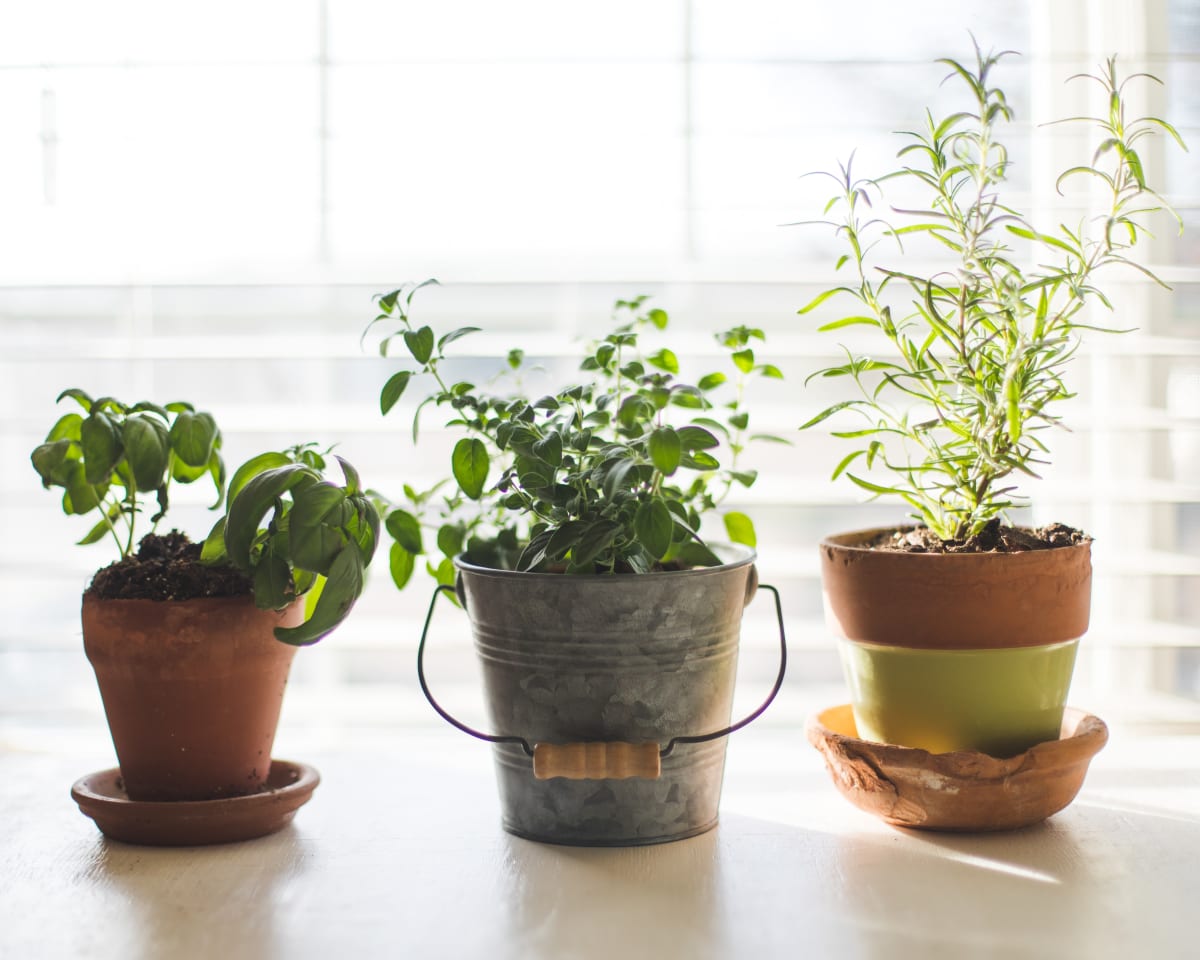[adinserter block=”2″]
If you’re like us, you may do a lot of cooking at home to eat healthier and save on soaring food prices. And in these times of great mental strain, nurturing something living and green does wonders for the psyche (If you want more ideas on how to save money on food and how to grow your own, read, 9 Kitchen Scraps for Regrowing Vegetables, Reducing Food Waste and Saving Cash) .
Herbs are particularly great for growing in small spaces. Not only are they forgiving; they smell beautiful, they’re pretty to look at, and they’re delicious.
“Herbs are great to grow in an apartment garden because many of them require a minimal amount of space,” says Susan Brandt, co-founder of Blooming Secrets, a gardening website that provides personalized selections based off location and gardening expertise. “And, once you figure out the amount of sunlight you have, you can figure out the right herbs that will work for you.”
If you’re a novice gardener, you might also want to consider a gardening kit (see our guide to growing your own gardening kit if this seems like a lot of work for you).
7 Easiest Herbs to Grow in an Apartment Garden
Most herbs are relatively low-maintenance. but some are more finicky than others. Bearing in mind ease, function, and use, these seven herbs are our top picks for everyone, from newbie gardeners to experienced growers.
1. Basil
Calling all pesto lovers! Basil isn’t exactly cheap at the grocery store, so, you can get a lot of bang for your buck when you grow your own. Basil thrives in pots or containers; just be sure to use a rich, organic potting soil.
Sunlight: Place basil in a sunny windowsill where it can get six hours of sun. It doesn’t like cold, so bring it indoors when temperatures dip.
Water: You can let the soil dry out slightly between waterings.
Harvesting: Don’t be afraid to cut your basil. If you don’t prune it (and use those yummy leaves), it will grow up and up until it sprouts flowers and eventually dies. You can harvest up to a third of the plant starting from the top and moving down. Make sure to cut the stems right at a pair of leaves. They will then branch off and continue to grow.
2. Chives
Quick-growing chives are easy to maintain both indoors and out. They grow 10 to 12 inches tall.
Sunlight: Chives will do well in a sunny windowsill.
Water: Chives like damp soil. Don’t let them dry out.
Harvesting: When the plants reach at least six inches tall, you can start trimming one to two inches for use. (And to promote growth!) If you do trim more, don’t cut all the way down to the root. Leave at least a half inch or more.
3. Mint
Mint is an aggressive grower, so it’s perfect to contain in a pot. And as Brandt explains, many varieties exist, including spearmint, peppermint, and chocolate mint.
Sunlight: Mint can tolerate some shade. Place mint in a windowsill where it can get good morning sun.
Water: Mint likes ample moisture. Don’t let it dry out.
Harvesting: Trim back mint regularly. You’ll extend its harvest if you pinch off flowers before blooming.
4. Oregano
Fragrant oregano loves heat and full sun, so if you have a balcony or deck, place it outside.
If you only have a windowsill available, choose the Greek variety. “Greek oregano has the best flower for culinary use and is the easiest to grow indoors,” Brandt says. Like mint, oregano spreads easily, so it’s great for containing in a pot for an urban garden.
Sunlight: Place your oregano on a windowsill, balcony, or deck that gets six to eight hours of sunlight. “The more sun the plant receives, the stronger the flavor,” Brandt says.
Water: Give the plant a thorough watering when the soil is dry to the touch. Don’t overwater.
Harvesting: When the plant is at least four inches tall, trim it back at a pair of leaves to encourage it to grow out not up.
5. Parsley
This green garnish is a great herb to have on hand in the kitchen. Keep in mind that parsley is a slow grower. “Be sure not to harvest too many leaves at any one time,” Brandt says.
Sunlight: Like chives and mint, parsley doesn’t require a ton of light. It’s adaptable! Place it on a sunny kitchen windowsill or in a more shady area on your balcony.
Water: Parsley likes moist soil, so don’t let it dry out.
Harvesting: When you want to snip off a few sprigs to use, trim from the outside of the plant.
6. Rosemary
Don’t skip adding this hardy, low-maintenance plant to your apartment garden. While you can certainly grow it indoors, rosemary’s divine, piney scent really emerges when the sun hits it. Consider putting it outdoors on a balcony or deck.
Luckily for urbanites, rosemary grows great in pots. “It is capable of growing into a larger, woody plant if it’s allowed to get older,” says Jon VanZile, a master gardener and author of “Houseplants for a Healthy Home.”
Sunlight: Rosemary prefers full sun and will need six to eight hours of sunlight a day to thrive indoors.
Water: Rosemary doesn’t like a lot of water. It can dry out between waterings. “The soil doesn’t have to be all that rich either,” Brandt says.
Harvesting: Like basil, don’t fret over cutting too much: You need to trim your rosemary considerably for it to grow. Once your rosemary starts shooting skyward, trim all of the stalks back to about four inches to promote growth. This will encourage it to bush out rather than grow up
7. Thyme
Thyme doesn’t need a lot of TLC. This aromatic herb grows similarly to mint and rosemary and is great for a pot or container.
Sunlight: Like oregano, thyme requires a lot of light. Make sure to put it outdoors or inside in a south-facing window.
Water: Thyme doesn’t like a lot of water. It can dry out between waterings.
Harvesting: Like rosemary, thyme needs regular pruning to encourage growth. Trim sprigs as needed for cooking and cut to promote growth.
10 Tips to Grow Herbs in an Apartment Garden Like a Pro
Don’t get too overwhelmed by each herb’s specific needs. A little general gardening know-how can help you make the most of your herb garden. Here are some gardening tips from the pros.
1. Start small
“If you’re new to growing herbs or your space is limited, start with two to three herbs,” Brandt says. “Select the ones that you believe you will use the most.”
2. Choose herbs you like to eat
Start your apartment herb garden with herbs you like to use or that you’d typically buy at the grocery store. “Once you get used to cooking with fresh herbs, there’s nothing better than having a plant on the windowsill you can snip a few leaves from to create salads and other dishes,” VanZile says. “Also, you’ll be much more motivated to take care of an herb you use, as opposed to an herb that you don’t really care much about.”
3. Pick the right spot
You may live in a concrete jungle, but try to find your herbs as much natural light as possible. “Place them in a sunny spot near a window or on a deck, where they’ll get at least six hours of sun daily,” Brandt says. “Windows that face south or southwest are your best shot at sun, though east or west-facing windows also will do. North-facing windows are not bright enough.”
4. Don’t put your herbs together, unless they like one another
Not all herbs are friends, so don’t put them in the same container. “Each herb may have its own needs, which conflict with another herb that you are trying to grow in the same pot,” Brandt says. For example, mint and parsley prefer moist soil, while rosemary, thyme, and sage want drier conditions.
“Putting them all together is a recipe for disaster since they don’t have the same watering needs,” Brandt says. “Each herb should have its own container with a drainage hole in the bottom.”
5. Give your plants room to grow
Don’t pick a pot simply because it’s cute. “You should choose pots that fit your personal style but they should be at least six inches in diameter to leave ample room for the herbs to grow,” Brandt says.
6. Inspect your herbs for pests
Check your herbs regularly for pests like spider mites, mealybugs, whiteflies, and aphids. VanZile suggests looking for tiny webs or droppings as well as the actual bugs.
“If you see an infestation, first move the plant away from any other plants so the pests don’t multiply. Then, decide if it’s worth keeping that plant at all,” he says. “It’s okay to get rid of an infested plant and just replace it. After all, you want to be very careful treating a plant with any type of insecticide if you’re planning to eat it.”
7. Don’t overwater your herbs
“The biggest mistake that gardeners and cooks make is to overwater their herbs,” Brandt says. “If the leaves start turning yellow, you are probably watering too much.”
8. Use high-quality potting soil
Invest in an organic, high-quality potting soil. “Don’t use soil from outdoors, as that’s a good way to bring unwanted pests into your home,” Brandt says.
9. Water the soil, not the leaves
Unless you want to grow fungus (you don’t!), water the soil of your herbs rather than the herbs themselves.
10. Don’t let your herbs sit in water
Make sure you give your herbs well-drained soil, so water doesn’t pool. And, don’t let them sit in a tray full of water. “Once you water your herbs, let them drain into the saucer for a few minutes, and then empty the saucer out so it’s dry,” VanZile says. “Leaving your plants sitting in water can cause root rot.”
The Takeaway
Pay attention to your plants, and they’ll tell you what they need. “If they are drooping, they need water. If they are turning yellow, they are probably getting too much water. If the leaf tips are turning brown, try raising the humidity by misting them,” VanZile says.
“There’s really no such thing as the ‘right way’ to grow a particular plant because most plants are pretty adaptable and no two environments are exactly the same,” he says. “Listen to your plants to find your ‘right way’ to grow plants and you’ll be successful.””
And if you really enjoy growing your own herbs, take the next leap and invest in a quality indoor grow kit to supplement your organic and fresh produce shopping habit! Our editor’s have hand selected some quality products that really liven up your living spaces.
Related on Organic Authority
Herb Garden Pruning 101: Your Hands-On Guide to Quick and Easy Care
What is Urban Gardening? The Hot Trend That’s Taking Over Cities
5 Practical Home Garden Solutions for City Dwellers (No More Excuses!)
[adinserter block=”2″]
Source link

